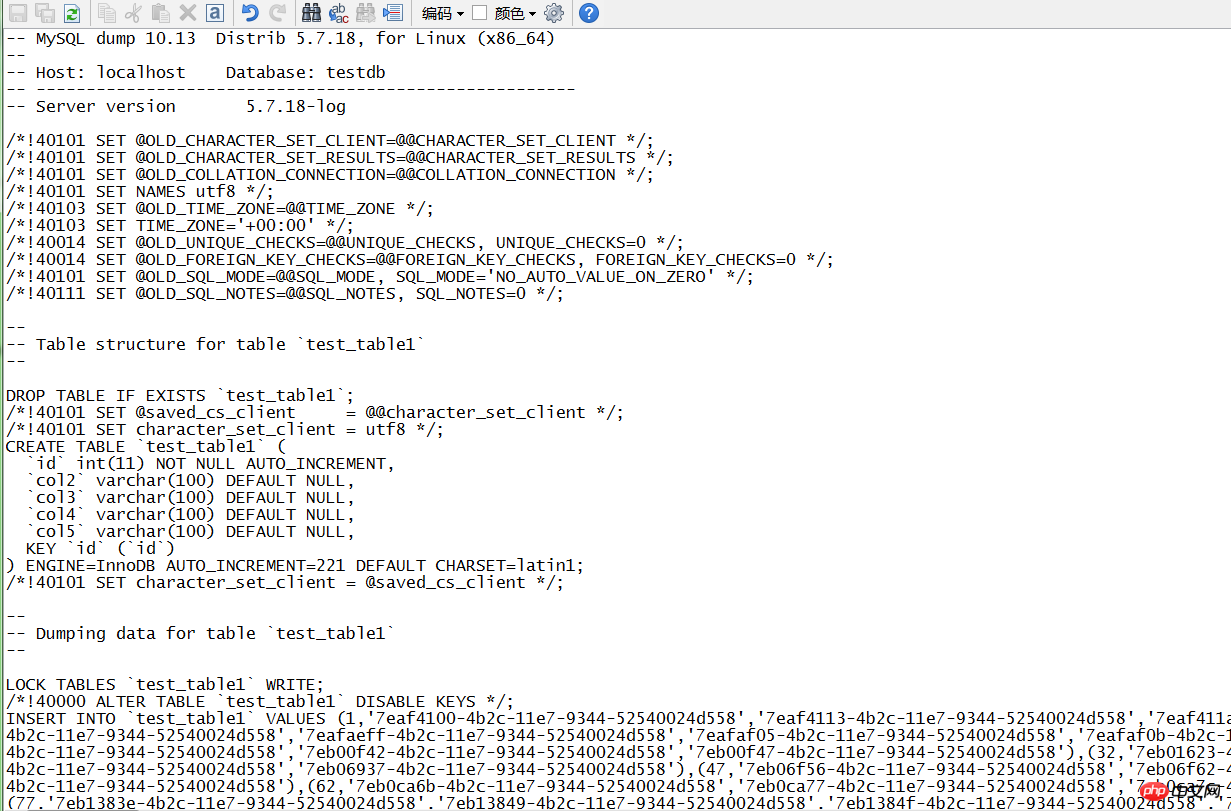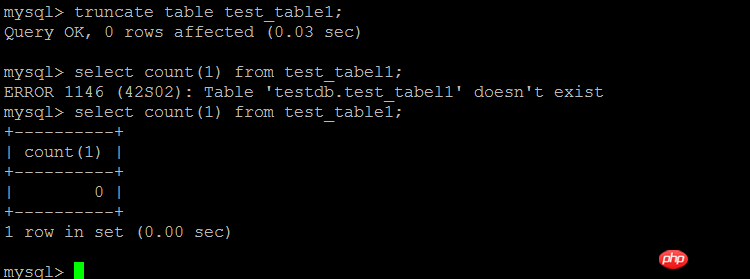 Database
Database
 Mysql Tutorial
Mysql Tutorial
 Logical backup and point-in-time restore in MySQL based on mysqldump and binary log log-bin
Logical backup and point-in-time restore in MySQL based on mysqldump and binary log log-bin
Logical backup and point-in-time restore in MySQL based on mysqldump and binary log log-bin
Source of this article:
This article only simulates the use of mysqldump and log-bin binary logs for simple testing, and is only used as personal study notes , which may still be far from practical application, and is only for reference.
Enable MySQL's bin-log binary log
Simulated restore requires the files and log-bin from mysqldump, so you need to start log- bin binary log.
When opening the binary log in mysql5.7.18, in addition to setting the location of log-bin, you also need to set a server-id. Previous versions of MySQL should not require this setting.
Let’s complain about open source software. Basically, each version has some differences from the previous version. It is often difficult to search for information online. Many things are different in different versions. This One thing to note.

After restarting, query the variables related to log_bin

mysqldump backup ( The basic use of export) data
Mysqldump command parameters are quite many. Let’s briefly record the commonly used commands, and use mysqldump backup (strictly speaking, export data) and binary log log-bin to perform database restoration operations.
-- Back up the entire testdb database, -l means add a read lock to all tables, -F (F must be uppercase, lowercase does not report an error and a single page is invalid) means rolling to generate a new log file
mysqldump -u root -p -l -F -h localhost testdb > usr/local/mysqlbak/test20170607_data.sql

The backed up file is create table And the script of insert into table

--Back up the two tables test_table1 test_table2 in the testdb database, adding --no-create-info means this backed up file The script without create table is just the information of insert into table
mysqldump -uroot -p -h localhost testdb test_table1 test_table2 --no-create-info> usr/local/mysqlbak/test20170606_1. sql
-- Back up part of the data in the test2 table in the testdb database, that is, back up the data in the test_table1 table that matches id<1000
mysqldump -uroot -p -h localhost testdb test_table1 - -where "id<1000" > usr/local/mysqlbak/test20170606_2.sql
For more mysqldump parameters, refer to:
In addition, mysql Log-bin replacement strategy:
Use index to cycle files, and will cycle to the next index
1 under the following conditions. Server restart
2. The server was updated
3. The log has reached the maximum log length max_binlog_size
4. The log is flushed mysql> flush logs;
Use the files backed up by mysqldump and the log-bin binary log to restore
First, in the following table Back up if there is data

Execute mysqldump -u root -p -l -F -h localhost testdb --master-data=2 > usr/local/mysqlbak/test20170607_data.sql

An option --master-data=2 is added here to note the current data in the backup file. log_bin file,
As for why this command is added, many blogs record that after using mysqldump to back up a file, modify the data, and then simulate the accidental deletion or downtime restoration of the database, and then use mysqldump to get the result. After the file is restored, then use log-bin to restore
Although they are all test simulations, there is an obvious problem. How do you know whether the log has scrolled after mysqldump and how many times it has scrolled?
If the log is not scrolled, restore the log-bin file according to the time point or position. If it is scrolled, how do you know how many log files have been scrolled?
You need to record it when mysqldump is executed and refresh the log. When using the newly generated log-bin file to restore the log, you can determine which logs to use for restoration.
With the --master-data=2 option, you can know the log_file location during mysqldump backup

Then continue to insert 10 pieces of data into the table

Then simulate the situation of accidentally deleting data at a certain point in time, truncate the test table, and the test table is empty at this time

First, use the file from mysqldump to restore the database. The file backup from mysqldump contains 100 rows of data.
Because the data in the backup file at the time of backup is 100 rows, after the restore, it is 100 rows, so there is no problem.

Then use log-bin to restore according to time points. As mentioned above, the file produced by mysqldump records the file name of log-bin after the log is refreshed,
Then you can judge whether the log has scrolled. If it has not scrolled, restore it according to the time point according to the latest log-bin in the figure below.

Perform a mysqldump backup and restore
mysql -u root -p testdb < usr/local/mysqlbak/test20170607_data.sql
Perform then perform another based on Time point restoration of bin-log
Mysqlbinlog --stop-datetime="2017-6-7 21:45:00" /var/lib/mysql/mysql-bin.000022 | mysql -u root -p testdb
Then the data comes back.
Restoration based on time point also needs to find out which log file is based on the time point. 
Summary:
This article only uses a simple example to model the restore operation of the database.The mysqldump backup mode is relatively simple and crude. Just exporting the data as an insert script will cause performance problems when restoring larger data. Mysqldump may not be suitable, and a more efficient xtrabackup is needed for backup and restoration.
The above is the detailed content of Logical backup and point-in-time restore in MySQL based on mysqldump and binary log log-bin. For more information, please follow other related articles on the PHP Chinese website!

Hot AI Tools

Undresser.AI Undress
AI-powered app for creating realistic nude photos

AI Clothes Remover
Online AI tool for removing clothes from photos.

Undress AI Tool
Undress images for free

Clothoff.io
AI clothes remover

AI Hentai Generator
Generate AI Hentai for free.

Hot Article

Hot Tools

Notepad++7.3.1
Easy-to-use and free code editor

SublimeText3 Chinese version
Chinese version, very easy to use

Zend Studio 13.0.1
Powerful PHP integrated development environment

Dreamweaver CS6
Visual web development tools

SublimeText3 Mac version
God-level code editing software (SublimeText3)

Hot Topics
 1385
1385
 52
52
 MySQL: Simple Concepts for Easy Learning
Apr 10, 2025 am 09:29 AM
MySQL: Simple Concepts for Easy Learning
Apr 10, 2025 am 09:29 AM
MySQL is an open source relational database management system. 1) Create database and tables: Use the CREATEDATABASE and CREATETABLE commands. 2) Basic operations: INSERT, UPDATE, DELETE and SELECT. 3) Advanced operations: JOIN, subquery and transaction processing. 4) Debugging skills: Check syntax, data type and permissions. 5) Optimization suggestions: Use indexes, avoid SELECT* and use transactions.
 How to open phpmyadmin
Apr 10, 2025 pm 10:51 PM
How to open phpmyadmin
Apr 10, 2025 pm 10:51 PM
You can open phpMyAdmin through the following steps: 1. Log in to the website control panel; 2. Find and click the phpMyAdmin icon; 3. Enter MySQL credentials; 4. Click "Login".
 MySQL: An Introduction to the World's Most Popular Database
Apr 12, 2025 am 12:18 AM
MySQL: An Introduction to the World's Most Popular Database
Apr 12, 2025 am 12:18 AM
MySQL is an open source relational database management system, mainly used to store and retrieve data quickly and reliably. Its working principle includes client requests, query resolution, execution of queries and return results. Examples of usage include creating tables, inserting and querying data, and advanced features such as JOIN operations. Common errors involve SQL syntax, data types, and permissions, and optimization suggestions include the use of indexes, optimized queries, and partitioning of tables.
 Why Use MySQL? Benefits and Advantages
Apr 12, 2025 am 12:17 AM
Why Use MySQL? Benefits and Advantages
Apr 12, 2025 am 12:17 AM
MySQL is chosen for its performance, reliability, ease of use, and community support. 1.MySQL provides efficient data storage and retrieval functions, supporting multiple data types and advanced query operations. 2. Adopt client-server architecture and multiple storage engines to support transaction and query optimization. 3. Easy to use, supports a variety of operating systems and programming languages. 4. Have strong community support and provide rich resources and solutions.
 How to use single threaded redis
Apr 10, 2025 pm 07:12 PM
How to use single threaded redis
Apr 10, 2025 pm 07:12 PM
Redis uses a single threaded architecture to provide high performance, simplicity, and consistency. It utilizes I/O multiplexing, event loops, non-blocking I/O, and shared memory to improve concurrency, but with limitations of concurrency limitations, single point of failure, and unsuitable for write-intensive workloads.
 MySQL and SQL: Essential Skills for Developers
Apr 10, 2025 am 09:30 AM
MySQL and SQL: Essential Skills for Developers
Apr 10, 2025 am 09:30 AM
MySQL and SQL are essential skills for developers. 1.MySQL is an open source relational database management system, and SQL is the standard language used to manage and operate databases. 2.MySQL supports multiple storage engines through efficient data storage and retrieval functions, and SQL completes complex data operations through simple statements. 3. Examples of usage include basic queries and advanced queries, such as filtering and sorting by condition. 4. Common errors include syntax errors and performance issues, which can be optimized by checking SQL statements and using EXPLAIN commands. 5. Performance optimization techniques include using indexes, avoiding full table scanning, optimizing JOIN operations and improving code readability.
 MySQL's Place: Databases and Programming
Apr 13, 2025 am 12:18 AM
MySQL's Place: Databases and Programming
Apr 13, 2025 am 12:18 AM
MySQL's position in databases and programming is very important. It is an open source relational database management system that is widely used in various application scenarios. 1) MySQL provides efficient data storage, organization and retrieval functions, supporting Web, mobile and enterprise-level systems. 2) It uses a client-server architecture, supports multiple storage engines and index optimization. 3) Basic usages include creating tables and inserting data, and advanced usages involve multi-table JOINs and complex queries. 4) Frequently asked questions such as SQL syntax errors and performance issues can be debugged through the EXPLAIN command and slow query log. 5) Performance optimization methods include rational use of indexes, optimized query and use of caches. Best practices include using transactions and PreparedStatemen
 How to build a SQL database
Apr 09, 2025 pm 04:24 PM
How to build a SQL database
Apr 09, 2025 pm 04:24 PM
Building an SQL database involves 10 steps: selecting DBMS; installing DBMS; creating a database; creating a table; inserting data; retrieving data; updating data; deleting data; managing users; backing up the database.



